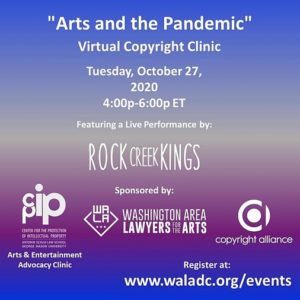The following post comes from Chris Wolfsen, a recent graduate of Scalia Law and a Research Assistant at CPIP.
 By Chris Wolfsen
By Chris Wolfsen
On October 27, 2020, CPIP Director of Copyright Research and Policy Sandra Aistars and students from her Arts & Entertainment Advocacy Clinic at Scalia Law School co-hosted a virtual event with Washington Area Lawyers for the Arts (WALA) and the Copyright Alliance. This virtual copyright clinic, focused on Arts and the Pandemic, provided information to artists wishing to protect their works as well as educators incorporating creative works into distance learning and museums wishing to make work available during the pandemic.
The event kicked off with a testimonial from the Rock Creek King’s Evan Moses, explaining WALA’s assistance in pairing the band with an attorney who advised them in securing the proper permits and asserting their First Amendment rights to perform outdoors during the COVID-19 quarantine for the Save Our Stages Movement. The band continues to raise awareness of the need for legislation to support local music venues during COVID-19 shutdowns. The Rock Creek Kings are calling on both the D.C. City Council and the U.S. Congress to assist these small businesses until they can reopen safely again.
Professor Aistars then turned the event over so her clinic students could answer questions submitted by attendees, with former clinic student, now adjunct professor, Dr. Stephanie Semler moderating. First was an explanation from David Ward on how artists can copyright their artwork. He explained that artists have a copyright as soon as their work is fixed in a tangible medium, but that registering that copyright with the United States Copyright Office will benefit artists. This registration will allow people seeking to license works to find artists and for artists to recover statutory damages in the case of a successful infringement claim. David explained that there are six categories of protectable works and shared a quick walkthrough of the process on https://copyright.gov/.
Bernard Horowitz then fielded a question on the minds of many artists: should I sign a COVID waiver in the studio or for the live event I participate in? Bernard explained that this question is a moving target—COVID waivers have not yet been litigated and Congress has not acted on the matter. He noted that we can look to current personal injury laws to draw conclusions about what may happen with this type of waiver and went on to explain the sharp distinction between the laws in Maryland and D.C. compared to those in Virginia.
Another topic that has been brought to the forefront during the pandemic is collaboration between artists and teachers. Yumi Oda walked attendees through the concept of fair use—a defense to copyright infringement—explaining that teachers using creative works during a live stream of their lesson can take certain measures to improve the likelihood that they will have a good argument that their use of a work in a classroom setting is a fair use. She explained that fair use is a fact-specific inquiry, but that educational use in a classroom setting is a classic example. Yumi also recommended teachers take additional steps such as protecting the lectures, and the creative works within them, with a password and removing student access at the end of the semester.
In a similar vein, Emily Gunberg discussed how museums are adapting to life in a pandemic. Curators have to consider whether they have the right to display a visual work online, which requires making a reproduction. This is a right that does not automatically attach when a museum acquires the physical work for display within the museum building. Emily noted that some types of online postings are usually acceptable, such as thumbnail images due to their lower resolution and limited use. For general availability to the public, such as a feature in a museum’s virtual tour, curators should revisit licensing agreements to ensure they have permission from rights owners.
Heather Uzer was given a more holistic and open-ended question: is the pandemic a catalyst for reform, or a death knell for independent creators? She emphasized that it is within our capacity to use this moment as an opportunity and as a catalyst for change. Artists’ right to protect their works still remain and there are many resources available to help with that protection. WALA, the Copyright Alliance, and many others are committed to protecting independent creators. David Ward also noted that several legislative efforts have gained attention, and that some record labels are holding special days to acknowledge creator efforts and supplement revenue for broadcasting artists by returning all revenues to performing artists on those days.
The event concluded with a performance by the Rock Creek Kings, live, but socially distanced from Crescendo Studios in Falls Church, Virginia. You can watch the video of their performance here on YouTube. One of the owners of Crescendo Studios, Eddie Fuentes, spoke about the importance of art and music in a time where we cannot be physically connected, and Evan, the lead singer of the band, reinforced the message during the performance This has been a year where people have missed weddings, graduations, funerals, and birthdays. Our communities rely on creators now more than ever to bring us together through shared experiences when we are six feet, or even oceans, apart.

